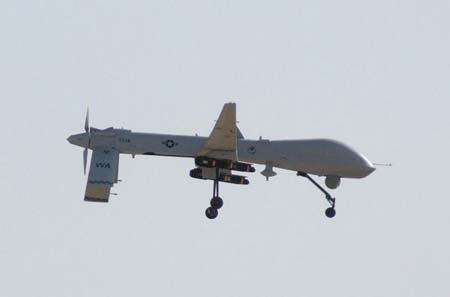A May 6 Air Force news release decla res that the number of combat air patrols conducted by its MQ-1 Predator unmanned aerial vehicles has doubled in one year, besting a Pentagon goal by some two years. An earlier report by USA Today cited this same statistic and noted that last month had set a new high for Predator CAPs. According to the Air Force, the MQ-1 force “now supply more than 13,400 hours of full motion video to ground forces every month” while it also provide precision strikes with Hellfire missiles. Army Gen. David Petraeus, head of the Multinational Force-Iraq and recently nominated to head US Central Command, called the Predator effort “unbelievable” and “path-breaking” in the International Zone and Baghdad. A combat air patrol normally comprises four Predator UAVs, but during the surge operations, USAF has maintained 24 continuous CAPs with a fleet of 76 MQ-1s, according to the release. The services uses crews in-theater to launch and recover the UAVs, but it has crews in the US that control the missions, providing the sensor data and directing attacks with Hellfires. The service has revamped both production of Predators and its training of operators to accommodate an ever-escalating requirement from DOD.
res that the number of combat air patrols conducted by its MQ-1 Predator unmanned aerial vehicles has doubled in one year, besting a Pentagon goal by some two years. An earlier report by USA Today cited this same statistic and noted that last month had set a new high for Predator CAPs. According to the Air Force, the MQ-1 force “now supply more than 13,400 hours of full motion video to ground forces every month” while it also provide precision strikes with Hellfire missiles. Army Gen. David Petraeus, head of the Multinational Force-Iraq and recently nominated to head US Central Command, called the Predator effort “unbelievable” and “path-breaking” in the International Zone and Baghdad. A combat air patrol normally comprises four Predator UAVs, but during the surge operations, USAF has maintained 24 continuous CAPs with a fleet of 76 MQ-1s, according to the release. The services uses crews in-theater to launch and recover the UAVs, but it has crews in the US that control the missions, providing the sensor data and directing attacks with Hellfires. The service has revamped both production of Predators and its training of operators to accommodate an ever-escalating requirement from DOD.
REFORPAC, the large-scale exercise in the Pacific planned for summer 2025, will be on a scale unseen by the Air Force in recent memory: nearly 300 aircraft spread across 25 locations.

